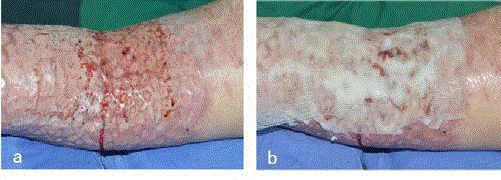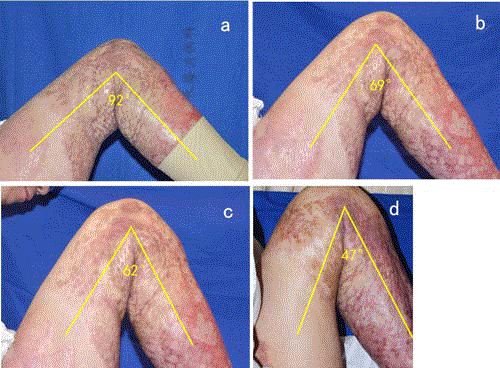Case Report
Improvement of Scar Contractures with Ablative Fractional CO2 Laser Treatments: A Case Report
He Fang, Kaiyang LV, Fang Zhang, Pengfei Luo and Zhaofan Xia*
Department of Burn Surgery, Second Military Medical University Affiliated Changhai Hospital, China
*Corresponding author: Zhaofan Xia, Department of Burn Surgery, Second Military Medical University Affiliated Changhai Hospital, Shanghai 200433, China
Published: 29 Aug, 2017
Cite this article as: Fang H, Kaiyang LV, Zhang F,
Luo P, Xia Z. Improvement of Scar
Contractures with Ablative Fractional
CO2 Laser Treatments: A Case Report.
Clin Surg. 2017; 2: 1604.
Abstract
Scar contractures from burn injuries often performed after the burn wounds healed, especially when
the burn wounds involving the joints. Although many therapeutic modalities have been used to the
administration of scar contractures, a great number of burn patients suffered from dysfunction of
major joints involved by burn injury. Ablative fractional CO2 laser (AFCL) treatment has become a
more popular therapeutic procedure for burn scars in the past decades. This report presents a case of
left knee joint scar contracture treatment with AFCL after 79% total body surface area (TBSA) burn.
A 20-year-old male patient underwent 79% TBSA flame burn. The burn wounds were healed
about 1-month post injury and classical anti-scar treatments including pressure garments, onion
extract cream and silicone gel and sheeting were applied as soon as the entire wounds were healed.
However, the major joints (both elbow joints and left knee joint) developed to contracture about 6
months later and the activities of daily living, such as dressing, ambulation, bathing and eating, were
affected by the contractures of joints. AFCL treatment was then applied and the function of involved
joints improved significantly and the pruritus was also alleviated.
In summary, AFCL treatments can improve burn scar contracture dramatically. Further researches
are needed to define optimal parameters of AFCL and the mechanisms.
Keywords: Burn injuries; Laser treatments; Scar
Introduction
Scar contractures from burn injuries often performed after the burn wounds healed, especially when the burn wounds involving the joints. Contractures are defined as failure to complete full range of motion of a joint [1]. Although many therapeutic modalities have been used to the administration of scar contractures, a great number of burn patients suffered from dysfunction of major joints involved by burn injury. The treatment modalities contain silicone gel sheeting, surgical excision, pressure treatments, tissue expanders, and interferon injections [2]. In the past decades, ablative fractional CO2 laser (AFCL) treatment has become a more popular therapeutic procedure for burn scars [3]. However, the treatment outcome with AFCL for burn scar contractures, especially for severely burned victims, is little known. Here, we report a case of left knee joint scar contracture treatment with AFCL after 79% total body surface area (TBSA) burn.
Case Presentation
A 20-year-old male patient underwent 79% TBSA flame burn when he worked. Burned areas
distributed among the whole body surface excluding legs (10% TBSA), buttock (4% TBSA), trunk
(2%, head (1% TBSA) and feet (5% TBSA). After successful fluid resuscitation, the patient underwent
mesh auto grafting procedures to the lower extremities and upper extremities. The burn wounds
were healed about 1-month post injury. Classical anti-scar treatments including pressure garments,
onion extract cream and silicone gel and sheeting were applied as soon as the entire wounds were
healed. About 6 months after the initial auto grafting, the patient suffered from scar contracture,
involving the major joints (both elbow joints and left knee joint). The left knee joint flexion range of
motion reduced gradually. The activities of daily living, such as dressing, ambulation, bathing and
eating, were affected by the contractures of joints.
Eight months after mesh auto grafting surgery, ablative skin resurfacing using an AFCL
(UltraPulse Encore, Lumenis, Yokneam, Israel) was administrated to treat the scar contracture.
Local anesthesia was performed on by using lidocaine gel on the contracture sites around the left
knee joint. The surgeon operated the laser system assisted by two assistants. One assistant was responsible for the smoke suction, and the other one was in charge
of keeping the patient’s body in a extensio position for operating.
The operation was carried on by using SCAAR FX mode, with the
parameter was as followed: 150 mJ energy, 300 Hertz, 5% density. The
operation lasted for 30 min and the bleeding volume was less than
10 milliliters (Figure 1a). The operated knee joint could be kept in a
extensio position when the operating was over and the operating site
was covered by hydrophobic dressing (Figure 1b), which was changed
the next day and was removed on Day 4 after operation. There was
no skin ulcer at the operating site. First-generation cephalosporin
antibiotics were given intravenously in the first 3 days after the
operation and the body temperature was kept in normal range during
the whole hospitalization.
The scar contracture improvement of left knee joint was followed
up and goniometer was used to measure the left knee range of motion.
The scar of left knee joint was assessed by Vancouver Scar Scale (VSS)
in pigmentation, thickness, vascularity and pliability. One month
after the AFCL treatment, the flexion function of left knee joint was
improved significantly. Before the operation, the knee flexion was
limited to 92 degrees and the VSS was 12. One month after the AFCL
treatment, the patient could flex the knee to 69 degrees by himself
and flex to 62 degrees by an outside force. The VSS was 9. The active
movement of his knee was improved to 47 degrees 6 months after
the AFCL treatment and the VSS was decreased to 6, which was
comparable to the normal adult (Figure 2). What’s more, the scarring
pruritus also improved.
Figure 1
Figure 1
AFCL operation was carried out under local anesthesia.
(a): The bleeding volume was less than 10 ml.
(b): The wound was covered by hydrophobic dressing after operation.
Figure 2
Figure 2
The scar contracture improvement of left knee joint.
(a): The knee flexion was limited to 92 degrees before AFCL treatment.
(b): The patient could flex the knee to 69 degrees by himself 1 month after
AFCL treatment.
(c): The patient could flex the knee to 62 degrees by an outside force 1 month
after AFCL treatment.
(d): The active movement of his knee was improved to 47 degrees 6 months
after the AFCL treatment..
Discussion
During the past decades, the survival rates of severe burn patients
have increased significantly [4]. As a result, more attentions have been
shifted to the functional recovery, especially burn scars after the burn
wounds healed. Scar contractures at the site of deep burn wounds
lead patients to suffering from physical and psychological problems,
which in turn may result in a decreased quality of life. The prevention
and treatment of scar contracture contains silicone gel, pressure,
exercise, radiotherapy, steroids and surgical correction. In the present
paper, we report a case of improvement of scar contractures with
ablative fractional CO2 laser treatments after the patient suffered from
severe burn injury.
Laser treatment has been used to improve our ability to treat
patients with scars. The mechanism of laser treatment involves
collagen and neocollagenesis remodeling [5], which is responsible
for the improvement of car contractures. AFCL treatment on skin
can create micro-thermal treatment zones in the epidermis and
upper dermis, the undamaged tissue left between these columns is
responsible for collagen formation and re-epithelialization [6,7]. The
AFCL was rarely reported in the administration of burn scars. The
patient in this case suffered scar contracture and underwent AFCL
treatment after burn injury and the outcome was satisfying.
The development of contractures was mainly associated with
burn size, burn depth and hospitalization. In the present case, the
burn depth of operation site was III degree and the burn wounds
covered the whole knee joint. The knee flexion function was limited
obviously and the VSS was high when the scar contracture developed
after wound healing. After treatment of AFCL, the function of knee
joint improved significantly and the pruritus was also alleviated.
According to our experience, hypothermia sometime occurs
when the AFCL was carried out. Many factors are associated with it,
including general anesthesia, body surface exposure without covers,
long operating time and low environment temperature. Perioperative
hypothermia is associated with clinical complications including
increased bleeding, wound-healing delay, and even cardiovascular
events [8]. In this case; we applied multiple strategies to avoid the
perioperative hypothermia. The AFCL operation was only carried
out at the site around left knee. As a result, the operating time and
body surface exposure were reduced obviously. What’s more, as the
operating area was limited, local anesthesia could be well tolerated
and was taken instead of general anesthesia, which was very
important for maintaining normal temperature during the operation.
For the patients with large area scar contracture, multistep operation
can be effective in preventing hypothermia. Two or even more laser
system applied in one AFCL operation for patients with large area of
scar contracture at the same time is another alternative method to
decrease incidence rates of hypothermia.
In summary, AFCL treatment can improve burn scar contracture
dramatically. Further researches are needed to define optimal
parameters of AFCL and the mechanisms.
Funding
This work was funded by National Nature Science Foundation of China (81120108015), National Basic Research Program of China (973 Program, 2012CB518100), “Twelfth Five-Year” Scientific Program of China (AWS11J008, AWS14C001, 201502028), and Clinical Key Discipline Project of Changhai (CH125510200), SMMU, Shanghai and China.
References
- Schneider JC, Holavanahalli R, Helm P, Goldstein R, Kowalske K. Contractures in burn injury: defining the problem. J Burn Care Res.2006;27(4):508-14.
- Xie Y, Zhu KQ, Deubner H,Emerson DA,Carrougher GJ,Gibran NS, et al. The microvasculature in cutaneous wound healing in the female red Duroc pig is similar to that in human hypertrophic scars and different from that in the female Yorkshire pig. J Burn Care Res.2007;28(3):500-6.
- Issler-Fisher AC, Fisher OM, Smialkowski AO, Li F,van Schalkwyk CP,Haertsch P, et al. Ablative fractional CO2 laser for burn scar reconstruction: An extensive subjective and objective short-term outcome analysis of a prospective treatment cohort. Burns. 2017;43(3):573-582.
- Ryan CM, Schoenfeld DA, Thorpe WP, Sheridan RL, Cassem EH, Tompkins RG. Objective estimates of the probability of death from burn injuries. N Engl J Med. 1998;338(6):362-6.
- Sobanko JF, Alster TS. Management of acne scarring, part I: a comparative review of laser surgical approaches. Am J Clin Dermatol. 2012;13(5):319-30.
- Levi B, Ibrahim A, Mathews K, Wojcik B,Gomez J,Fagan S, et al. The Use of CO2 Fractional Photothermolysis for the Treatment of Burn Scars. J Burn Care Res. 2016;37(2):106-14.
- Stephan FE, Habre MB, Helou JF, Tohme RG, Tomb RR. Fractional CO2 laser treatment for a skin graft. J Cosmet Laser Ther. 2016;18(1):46-7.
- Bittner EA, Shank E, Woodson L, Martyn JA. Acute and perioperative care of the burn-injured patient. Anesthesiology. 2015;122(2):448-64.


